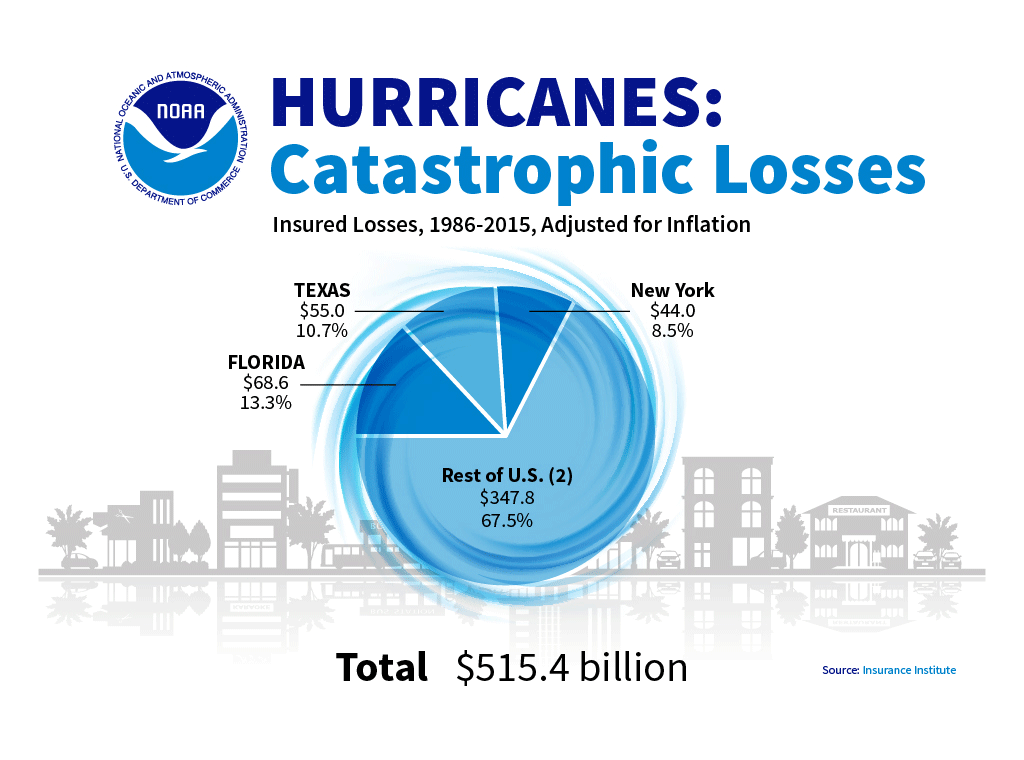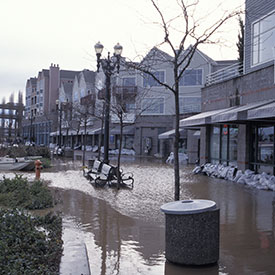$136 Billion: 2018 and 2019 in Review
2018 and 2019 each saw 14 billion-dollar weather disasters. Associated losses for 2018 were estimated at $91 billion and for 2019 were $45 billion—for a combined total of $136 billion. In 2019, historic flooding in the Midwest caused $10.8 billion worth of damages throughout millions of acres of land. This was one of the costliest inland U.S. flooding events on record. In 2018, Hurricanes Michael and Florence, and the western wildfires, accounted for about $73 billion of the $91 billion total for the year.
Hurricane Dorian: After devastating the Bahamas (as the worst natural disaster in the country’s history) in early September 2019, Dorian made landfall on the Outer Banks of North Carolina on September 6 as a category 1 hurricane. Dorian's intensification to a category 5 storm marked the fourth consecutive year in which a maximum category 5 storm developed in the Atlantic basin—a new record. Dorian also tied the record for maximum sustained wind speed for a landfalling hurricane in the Atlantic (at 185 miles per hour), sharing the record with the historic 1935 Labor Day Hurricane.
Hurricane Florence: Florence made landfall near Wrightsville Beach, North Carolina, on September 14, 2018 and became one of the deadliest and costliest hurricanes to ever impact the Carolinas. It caused at least 51 deaths and record flooding.
Hurricane Michael: Michael made landfall near Mexico Beach, Florida on October 10, 2018, with sustained winds of 155 miles per hour. It was the most intense hurricane on record to make landfall along the Florida Panhandle, and caused at least 45 deaths—as well as widespread devastation—across the Panhandle, Georgia, the Carolinas, and Virginia.
Western Wildfires: Two wildfires impacted California in early November 2018; the Camp Fire burned more than 153,000 acres, caused at least 88 fatalities, and destroyed more than 18,000 structures in Northern California. It was the most destructive and deadliest wildfire on record in California, and the deadliest wildfire in the U.S. since 1918. In Southern California, the Woolsey Fire destroyed more than 1,500 structures and killed at least three people in and around Malibu.
2017: Highest Costs Ever
The cumulative costs of the 16 separate billion-dollar weather events in the U.S. in 2017 was $306.2 billion, breaking the previous cost record of $214.8 billion (2005). It is estimated that Hurricane Harvey alone had total costs of $125 billion—second only to Hurricane Katrina in the period of record, which had an approximate cost of $161 billion.
Harvey, Irma, and Maria: Making History
The 2017 Atlantic hurricane season was among the top seven most intense ever recorded. Record-breaking statistics, in addition to costs, include the following:
Hurricane Harvey: Harvey was the most significant tropical cyclone rainfall event ever recorded in U.S. history, both in scope and peak rainfall amounts. The highest storm total rainfall report from Harvey was 60.58 inches. Prior to Hurricanes Irma and Maria, Harvey became the deadliest U.S. hurricane in terms of direct deaths since Sandy (2012) and the deadliest hurricane to hit Texas since 1919. It was the first category 4 hurricane to make landfall in Texas since 1961, and the first category 4 to make landfall in the U.S. since 2004. Harvey lasted 117 hours, beating the previous record for duration of Hurricane Fern in 1971.
Hurricane Irma: With maximum winds of 185 miles per hour, Irma became the strongest storm on record to exist in the Atlantic Ocean outside of the Caribbean and Gulf of Mexico. It sustained those maximum winds speeds for 37 hours and spent three consecutive days as a category 5 hurricane—making it the longest of any cyclone in the world since 1932 to maintain that intensity. The occurrences of Harvey and Irma—making landfall within two weeks of each other—were the first time in recorded history that two category 4 or higher hurricanes struck the U.S. mainland in the same year.
Hurricane Maria: Maria was the first category 5 hurricane ever to make landfall in Dominica, and the strongest hurricane to make landfall in Puerto Rico since 1928. It was the deadliest of 2017’s three major storm, with over 2,900 fatalities.

Nine in a Row
2019 marked the ninth consecutive year with eight or more billion-dollar disasters, and was the fifth consecutive year in which 10 or more billion-dollar weather and climate disaster events affected the United States.
Millions Powerless
No event in U.S. history has recorded so many people without power for as long as what occurred in Puerto Rico and the U.S. Virgin Islands following Hurricane Maria. Seven weeks after the storm hit, 50 percent of Puerto Rico was still without power. Of the top five power losses in the nation’s history, Irma is number four, with 20 million people in the U.S. and 15 million in the Caribbean affected.*
Tropical Cyclones
Of the 246 (as of April 2019) weather disasters since 1980, tropical cyclones have caused the most damage: $927.5 billion total, with an average cost of almost $22 billion per event. Of the 258 U.S. weather disasters since 1980, tropical cyclones have caused the most damage: $945.9 billion total, with an average cost of almost $21.5 billion per event. They are also responsible for the highest number of deaths: 6,502 since 1980.
Hurricane Sandy
Over a dozen states were impacted by Hurricane Sandy in October 2012. Sandy caused $18.75 billion in insured property losses, excluding flood insurance claims. Estimates of insured losses for Hurricane Matthew (2016) range from $1.5 billion to $7 billion in the U.S.


